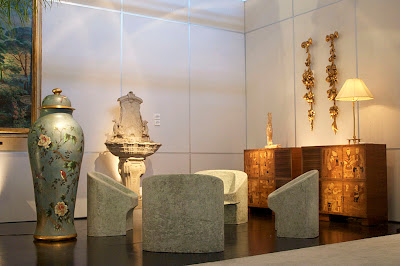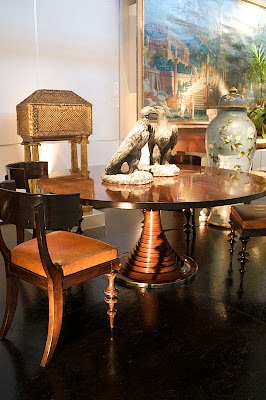I caught up with Bob, a longtime friend of mine, at the recent San Francisco Fall Antique Show. Bob, who travels constantly to buy in Paris, London, Lisbon, Rome, Stockholm, is considered one of the leading antique dealers in the world. Yet he is deeply immersed and involved in the modern design world and his antennae tingle for new directions, the reality of design today, and the onward march of changing tastes and trends.
Sit down with us and gather insights and new ideas. And take a close look at Bob’s collection presented at the San Francisco Fall Antique Show at the end of October. His collection perfectly illustrates his concepts.
Sit down with us and gather insights and new ideas. And take a close look at Bob’s collection presented at the San Francisco Fall Antique Show at the end of October. His collection perfectly illustrates his concepts.
The Style Saloniste Exclusive Interview:
DDS: Your approach to the San Francisco Fall Antiques Show collection was very eclectic this year. Concrete, fine woods, antiquities, twentieth-century, obscure designers and countries, marble, iron--and an array of exotic sources marked your distinguished and inspired selection.
THERIEN/Bob Garcia: Curated is a word that has become a kind of catch-all word. What that really means is today’s approach in interiors is somewhat like a collection, a selection, a hand-picked grouping, and each piece is spectacular.
The focus is on the individual merits of each piece rather than the relationship of pieces to each other.
The best and most modern approach is that you have noteworthy pieces, rather than trying to achieve cohesion or a theme or a look. It’s the opposite of a period room or that dated concept of creating a pre-packaged and pre-set ‘look’ (such as ‘French country’ or ‘Belgian’ or ‘bohemian chic’ etcetera).
I see a parallel in fashion where there is not the old relationship with shoes, hat, gloves, but individual pieces assembled together. Wearing what you love. I am challenging old ways of doing things, and making a statement with unique individual pieces. Personal expression, individual taste, some eccentricity perhaps, make it work. Live with the pieces you love.
DDS: Which of your offerings on this year’s Therien stand (pictured here) was first to go?
T/BG: The pair of Italian Baroque chairs, early 18th century, silver gilt, acquired in Rome. They were snapped up quickly and that shows that period antiques are not out of the game at all, and there is still great interest in beautiful and rare pieces. These chairs possess extraordinary attributes. The silhouette was harmonious and right, and deeply carved scrolling volutes, expressive forms, the glimmer of reflected light from the traces of silver gilt all lend to these the feeling of sculpture, and of forms that can be appreciated for their own sake.
DDS: I loved the blue urns by Luneau. They had such stature and theatricality. Tell us more. Weren't you tempted to keep them?
T/BG: Antique dealers do have to avoid giving in to our temptations and keeping things for ourselves! These urns are as you say, quite tall, and theatrical. They were designed by Jean Luneau possibly for one of Charles de Beistegui’s many Anglo Chinese follies at Chateau de Groussay in Montfort l’Amaury, France. Luneau created similar urns in the 1950’s there, and these speak to the 18th century inspired neo-baroque taste of the mid 20th century. It’s an elaborate decorative style rather ignored until today, perhaps because the style did not fit into established ideas of Modernism. This is where bloggers are ahead of the game, revealing designs and a taste that was perhaps overlooked. These urns are pure fantasy, and they speak a luxurious 20th century approach, exaggeration, pure color, with heightened cinematic effects.
DDS: The 'wallpaper' you presented graphically in your stand (see images) with its classical scenes and beautiful hues. It's hard to find these original wallpaper panels in such fine condition. Tell us more.
T/BG: The wallpaper panel by Dufour, early 19th century, was projected away from the wall by a few feet. This was our concept for the stand this year, that objects would stand alone on their own merits, disassociated from the physical walls of the stand. We used a similar treatment of projection in our display with the Genovese mirror and the Regence style fountain. The Dufour panel was treated as a work of art, disassociated from the walls, and you would see it for what it is, rather than part of a decorative scheme.
DDS: The Roman giltwood chairs are so beautiful. The silhouette is harmonious, and these would look wonderfully elegant in any room. And the chunky cubist concrete chairs are a bit of a departure for you. Eclectic, definitely.
T/BG: With our venture into incorporating 20th century design a few years ago, Wily Guhl’s designs have that individual merit we look for. Guhl’s work is part of the hallmarks of 20th century design, the plasticity of forms seen here interpreted in cement. They do have some of that quality of forms seen in the postwar works of sculpture by the English artists Henry Moore and Barbara Hepworth, so they are not only chairs, objects of utility, but also works of sculpture. I like the juxtaposition.
DDS: Tips on finding and living with eclectic antiques and 20th-century rare objects.
DDS: Tips on finding and living with eclectic antiques and 20th-century rare objects.
T/BG: Designers today must also live in the real world, not just searching on the net. People have to experience design as part of life. The best way to collect is making a habit of seeing, doing, talking, traveling, attending and studying museum exhibitions, even going to flea markets, and visiting galleries in person- being open to new things. When you are out in the world there is the serendipity of finding things you never knew existed. Reading about and attending auctions, immersing yourself in lectures and seminars on design and antiques make rewarding introductions.
Yes, search for your favorites on the Internet, but also spend time in antiques galleries, wander through museums and into obscure studios and funky neighborhoods. Talk to dealers, chat with curators, be open-minded.
Yes, search for your favorites on the Internet, but also spend time in antiques galleries, wander through museums and into obscure studios and funky neighborhoods. Talk to dealers, chat with curators, be open-minded.
DDS: There's an art, though, in combining Constructivist and Rococo and concrete and metal and carved wood. What are your guidelines?
T/BG: It is a matter of visual trial and error. Assuming that each piece has its own integrity, it requires working in real time to make compositions that satisfy.
There is no rulebook, or guidelines but an intuitive sense.
Compositions--that is the right word to describe it. It’s the opposite of the old idea of ‘matching’. Today, the goal is juxtaposition, contrast, variety, surprise.
I like the contrast of perhaps rough concrete and fine wood, or limestone and ceramic, or shiny and matte. When everything in a room ‘matches’ it can look lifeless, and rather like a museum.
When we put the stand together it is all about paring down and elimination. Even when the stand is finished, I will come back the next day and pull something out, and it is so much better. It is knowing how to edit. Move pieces around. Take away, Add. Move. Get everything into a harmonious relationship. Even top designers and dealers work with trial and error.
DDS: This concept means it’s best to create a room with walls and decor that can frame a changing roster of collections. It requires a more curious and enquiring mind? In this eclectic approach, you create your own rules. You’re not re-creating ‘theme design’.
There is no rulebook, or guidelines but an intuitive sense.
Compositions--that is the right word to describe it. It’s the opposite of the old idea of ‘matching’. Today, the goal is juxtaposition, contrast, variety, surprise.
I like the contrast of perhaps rough concrete and fine wood, or limestone and ceramic, or shiny and matte. When everything in a room ‘matches’ it can look lifeless, and rather like a museum.
When we put the stand together it is all about paring down and elimination. Even when the stand is finished, I will come back the next day and pull something out, and it is so much better. It is knowing how to edit. Move pieces around. Take away, Add. Move. Get everything into a harmonious relationship. Even top designers and dealers work with trial and error.
DDS: This concept means it’s best to create a room with walls and decor that can frame a changing roster of collections. It requires a more curious and enquiring mind? In this eclectic approach, you create your own rules. You’re not re-creating ‘theme design’.
T/BG: There is an appropriateness for an interior that still drives what you can do. I would not attempt the Baroque chairs and the Regence fountain in Aspen, perhaps. For an eclectic approach you need an interior that has the sense of a gallery space. Each piece must be shown to advantage using a kind of counterpoint in putting together these collections. If you notice in our stand, each piece had breathing room. You cannot achieve this effect of counterpoint when everything is crammed together. Each piece needs to make its own statement without confusing chatter. That is critical to each piece being appreciated.
DDS: Bob, you see everything great on your professional trips throughout Europe. Your point that Rococo and Baroque are still of great interest is telling. What is it about a specific antique, a fine antique, that will always make it an object of beauty, transcending fads and trends?
T/BG: The word I keep coming back to is integrity whether in an 18th-century antique of in a 20th-century piece. There must be logic and refinement and integrity of design in the piece itself. The craftsmanship must be the best. The finishes must be exquisite. Even a factory-made piece should be superbly crafted. An Eames chair is an Eames chair and is timeless because of that, and a beautiful antique is a work of art. The best pieces are fully realized and express ideas. They are not trivial. They express beauty of the highest level. They take your breath away. There is refinement in the details. Quality is essential.
DDS: Give us a hint about what you are constantly seeking.
T/BG: I think it goes back to being out in the world, and open to things and you never really know what you will find. I attend auctions or galleries, and meet collectors, always seeking the most rare pieces, the most exquisite, the best for our clients. But I’m open-minded. In the world of collection it is best to see what really grabs you, speaks to you. It is then putting together these things in unexpected ways. It is all about serendipity. When you are always studying, looking, searching, excited—you create your own good fortune. It is a very exciting world of antiques today.
DDS: Thank you so much, Bob. It is always such a pleasure to see your collections.
T/BG: The word I keep coming back to is integrity whether in an 18th-century antique of in a 20th-century piece. There must be logic and refinement and integrity of design in the piece itself. The craftsmanship must be the best. The finishes must be exquisite. Even a factory-made piece should be superbly crafted. An Eames chair is an Eames chair and is timeless because of that, and a beautiful antique is a work of art. The best pieces are fully realized and express ideas. They are not trivial. They express beauty of the highest level. They take your breath away. There is refinement in the details. Quality is essential.
DDS: Give us a hint about what you are constantly seeking.
T/BG: I think it goes back to being out in the world, and open to things and you never really know what you will find. I attend auctions or galleries, and meet collectors, always seeking the most rare pieces, the most exquisite, the best for our clients. But I’m open-minded. In the world of collection it is best to see what really grabs you, speaks to you. It is then putting together these things in unexpected ways. It is all about serendipity. When you are always studying, looking, searching, excited—you create your own good fortune. It is a very exciting world of antiques today.
DDS: Thank you so much, Bob. It is always such a pleasure to see your collections.
| FORGED IRON, LEATHER AND GLASS TABLE Glass top secured by bolts to three looped and flaring iron legs, strapping, centering circular iron ring. 1960’s France |
Photo credits:
Philip Bewley and Philip Stites, Therien & Co.
Used with express permission.
phone: 415.956.8850 or 310.657.4615












12 comments:
Diane, I so enjoyed this interview and accompanying descriptions. As I am sure you know, there are few things more frustrating on blogs than unidentified or mis-identified images. Your professionalism is greatly appreciated!
Dear Diane,
Loved your supreb presentation, the exchange of ideas on design and more. Thank you and warmest regards,
Diane, Thank you so much for the superb interview. So many important questions answered. The antiques and decorative arts market is in flux; this interview answers the question of where to find ones footing. Mary
What a great interview! So insightful and interesting.
Diane,
even if I don't comment much be sure I follow you closely! This interview made me love even more rooms that are NOT pre-packaged or with a pre-set look, this was not and will never be my style. Stunning images showing a brilliant mind.
Hi Dear,
The SF Antique show was on my list this fall for my visit to SF, but there was no chance to travel close to departure this time.
Bob Garcia absolutely has a great approach for an antique dealer's vision of today's market and I think it's the right thing too.
I'll try to be in time for the next fall show.....
Great post as always Diane! Your are spectacular!!
Cheers,
Ingela
Dear Friends, near and far--
Hello, John, Philip, Mary, Gerald, Albarosa and Ingela-
I'm delighted you found this antiques 'symposium' of value and interest.
There is such a debate about 'are antiques valid now' or 'are antiques over' or 'how to live with antiques in the modern world'--and Bob answers some of these queries.
Important to note: his collection shown here perfectly illustrates that contrast and juxtaposition make it work. Andree Putman also spoke of combining 'old with new; curvy with straight; elaborate with simple; rough with smooth.'
That concept clarifies how best to do 'eclectic' and how to work with antiques.
cheers to all, DIANE
Diane- Having seen the Therien stand in person, I especially appreciate this post. I always find their mix of pieces and styles intriguing. A most interesting interview!
Diane, I just realized I clicked Charlotte Moss's interview and left a comment on a rather old post... I clicked on it because I just met Charlotte when she was in Omaha for the Lauritzen Gardens Antique Show this September! She was a wonderful speaker (as was Suzanne Rheinstein) and I loved your interview!!
I also enjoyed this interview... I love the idea of creating a room that can frame a changing roster of collections... Lord knows, I have a changing roster!
Jan
The French Tangerine
Hello Diane,
Thank you for this brilliant interview... Not only are the selections and the overall interiors breathtaking but the thoughts behind the design spot on... for me anyway... xv
P.S Diane...I have added your beautiful books to SHOP FRENCH ESSENCE...such a wonderful addition... Thank you, xv.
Thank you for another lovely post. I wasn't able to attend this year's event but a thoughtful friend brought me home a care package. Shiree'
Post a Comment